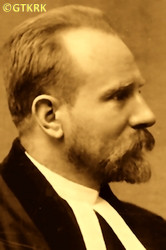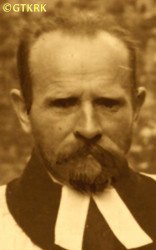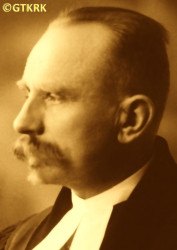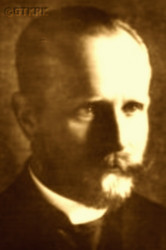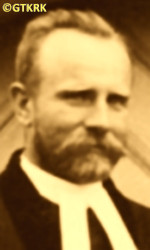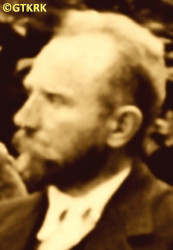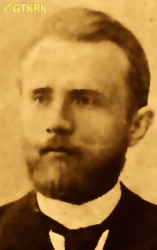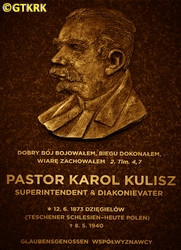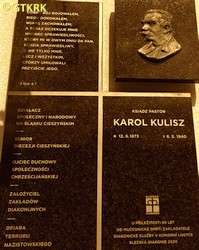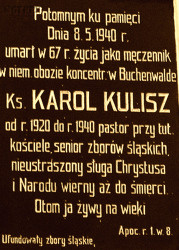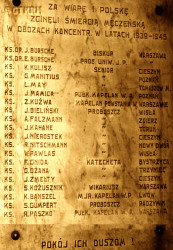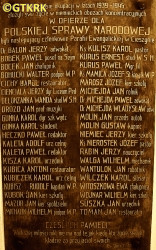Roman Catholic
St Sigismund parish
05-507 Słomczyn
85 Wiślana Str.
Konstancin deanery
Warsaw archdiocese, Poland
full list:
displayClick to display full list

searchClick to search full list by categories
wyświetlKliknij by wyświetlić pełną listę po polsku

szukajKliknij by przeszukać listę wg kategorii po polsku

Martyrology of the clergy — Poland
XX century (1914 – 1989)
personal data
surname
KULISZ
forename(s)
Charles (pl. Karol)
function
pastor
creed
Evangelical Church of the Augsburg Confession in Poland EA
diocese / province
Cieszyn seniority (commissariat) / diocesemore on
en.wikipedia.org
[access: 2016.04.23]
honorary titles
„Polonia Restituta” Cross — 4th Class, Officer'smore on
en.wikipedia.org
[access: 2019.04.16]
(02.05.1924)
date and place
of death
08.05.1940

KL Buchenwaldconcentration camp
today: n. Weimar, Weimar urban dist., Thuringia state, Germany
more on
en.wikipedia.org
[access: 2022.01.09]
details of death
During the Austrian rule (in part of portioned Poland), a Polish national activist in Cieszyn Silesia.
At the end of World War I — after the issuance on 16.10.1918 by the Emperor of Austria–Hungary, Charles I of Habsburg, of the „To My Faithful Austrian Peoples” Germ. Völkermanifest (Eng. people's manifesto), announcing the transformation of the empire into a federal state, composed of autonomous „state organisms” of nationalities — a local agreement was reached between the Polish and Czech sides on the division of responsibility and power in the region on 05.11.1918. After the end of World War I on 11.11.1918 and the announcement by Emperor Charles I of his resignation from participation in government, in 12.1918, together with other evangelical pastors, signed the memorial „Voice of the Polish Evangelical Clergy in the Matter of the Annexation of Eastern Silesia to Poland”.
On 23.01.1919, taking advantage of the difficult situation of Poland, attacked by Ukrainians and fighting in the Greater Poland Uprising, Czech troops — breaking the agreement of 05.11.1918 — attacked the region. Achieved several successes, including on 28‐30.01.1919 near Skoczów, committing however several crimes against Polish prisoners of war and civilians in the process. Immediately afterwards — under pressure from the Entente countries victorious in World War I — a truce was reached. On 03.02.1919, defined in the the so‐called Paris Agreement, the new demarcation line was unfavorable for Poland. Therefore, in 03.1919, Bp Julius Bursche, Warsaw Senior Superintendent of the Evangelical–Augsburg Church, submitted the previously created memorial to the Peace Conference in Versailles near Paris.
After signing the so‐called Treaty of Versailles on 28.06.1919 in Paris, by virtue of which, among other things, many local border disputes were left to later decisions of the Council of Ambassadors — e.g. the division of Cieszyn Silesia between Czechoslovakia and Poland was to be decided in a plebiscite — in 07.1919 in Paris, together with pastor Joseph Mamica, defended this memorial. As a delegate of the National Council of Cieszyn Silesia, also intervened in London. Again intervened in this matter, as a member of the Polish delegation, in the summer of 1920 — when a Russian offensive was approaching Warsaw during the Polish–Russian War of 1919‐1921 (on 09.08.1920, Czechoslovakia declared strict neutrality, blocked any transit of war materials with help for Poland, refused to let 30,000‐stron cavalry unit from Hungary pass through its territory, tried to stop the French–British military–political mission to Poland in Prague, and even began to organize Ukrainian divisions hostile to Poland). The Council of Ambassadors decided then, in 07.1920, under pressure from the Czechs and due to Poland's weakness, on the arbitrary division of Cieszyn Silesia, waiving the plebiscite, leaving a large part of the region, called Trans‐Olza — with a Polish majority — in Czechoslovak hands.
After the division of Cieszyn Silesia left Ligotka Kameralna and moved to Polish Cieszyn, where became a parish priest.
After German and Russian invasion of Poland in 09.1939 and start of the World War II, after start of German occupation, arrested by the Germans on 23.09.1939.
On 29.09.1939 transported to KZ Skrochowice n. Opawa concentration camp (later incorporated into Polenlager system of slave labour camps).
There had his eye gouged out.
On 05.10.1939 transported to Rawicz prison and on 17.10.1939 to KL Buchenwald concentration camp.
On 08.05.1940 called out through loudspeakers to the camp's gate and locked in a barrack from which nobody ever came back alive.
According to death report, issued in KL Buchenwald, the „honest” otherwise German „medical doctors” and formalists — and at the same time, unrivaled fairy tale spinners — noted that Germ. „Der Pole Karl Kulisz, geb. 12.6.73 zu Dziegislow, ist heute um 10.50 Uhr an Herzschwäche, Alterschwäche verstorben” (Eng. „The Pole Karl Kulisz, born on 12.6.73 in Dziegielóww, died today at 10:50 a.m.
from heart failure and old age”).
prisoner camp's numbers
1597/9589Click to display source page (KL BuchenwaldClick to display the description)
cause of death
extermination
perpetrators
Germans
sites and events
KL BuchenwaldClick to display the description, RawiczClick to display the description, CieszynClick to display the description, PolenlagerClick to display the description, «Intelligenzaktion Schlesien»Click to display the description, «Intelligenzaktion»Click to display the description, Regierungsbezirk KattowitzClick to display the description, Ribbentrop‐MolotovClick to display the description
date and place
of birth
12.06.1873

Dzięgielówtoday: Goleszów gm., Cieszyn pov., Silesia voiv., Poland
more on
en.wikipedia.org
[access: 2022.01.28]
parents
KULISZ Adam
🞲 1824, Dzięgielówtoday: Goleszów gm., Cieszyn pov., Silesia voiv., Poland
more on
en.wikipedia.org
[access: 2022.01.28] — 🕆 ?, ?

HŁAWICZKA Anne
🞲 19.02.1831, Dzięgielówtoday: Goleszów gm., Cieszyn pov., Silesia voiv., Poland
more on
en.wikipedia.org
[access: 2022.01.28] — 🕆 26.06.1901, Dzięgielówtoday: Goleszów gm., Cieszyn pov., Silesia voiv., Poland
more on
en.wikipedia.org
[access: 2022.01.28]
presbyter (holy orders)
ordination
06.01.1899

positions held
1920 – 1939
parish priest — Cieszyntoday: Cieszyn gm., Cieszyn pov., Silesia voiv., Poland
more on
en.wikipedia.org
[access: 2021.12.18] ⋄ EA church (Jesus Church) ⋄ EA parish — first elected in 1913, but not approved by the Austrian authorities; also: founder of the „Ebenezer” Care and Education Center for orphans, the elderly and the infirm (1923), the Polish Diaconate (1923) and the People's University (1924) in Dzięgielów
1921 – 1936
superintendent–senior — Cieszyn EA seniority (commissariat)
1907 – 1920
parish priest — Komorní LhotkaTrans‐Olza
today: Frýdek‐Místek dist., Moravian‐Silesian reg., Czechia
more on
en.wikipedia.org
[access: 2023.03.24] ⋄ EA parish — also: founder of the „Bethesda” nursing home for the elderly and infirm (1913), spiritual father and leading activist of „Christian Community” neo–pietistic movement (from 1905, author of the statute 1906)
1899 – 1907
vicar — Komorní LhotkaTrans‐Olza
today: Frýdek‐Místek dist., Moravian‐Silesian reg., Czechia
more on
en.wikipedia.org
[access: 2023.03.24] ⋄ EA parish
till 1899
student — Erlangentoday: Erlangen urban dist., Middle Franconia reg., Bavaria state, Germany
more on
en.wikipedia.org
[access: 2023.03.24] ⋄ theology, Friedrich–Alexander–Universität (Eng. Friedrich–Alexander University)
from 1894
student — Viennatoday: Vienna state, Austria
more on
en.wikipedia.org
[access: 2020.07.31] ⋄ philosophy and evangelical theology, Alma Mater Rudolphina Vindobonensis (Eng. University of Vienna), i.e. Rudolphina
publisher and editor of the magazines „For Everyone” (1901‐1909), „Word of Life” (1910‐1919), „Church Voice” (1925‐1938) and „Hour” (1939)
married — three children
others related
in death
BANSZELClick to display biography Charles, BIELIŃSKIClick to display biography Joseph, BURSCHEClick to display biography Edmund, BURSCHEClick to display biography Julius, FALZMANNClick to display biography Alexander Charles, FREYDEClick to display biography Alfred, GNIDAClick to display biography Francis, GUMPERTClick to display biography Steven Edward, GUTKNECHTClick to display biography Bruno, GUTSCHClick to display biography Sigismund, HAUSEClick to display biography Paul Henry, KAHANEClick to display biography George, KOŻUSZNIKClick to display biography Stanislav, KUŹWAClick to display biography Sigismund, LEHMANNClick to display biography George, MAYClick to display biography Leo Witold, MAMICAClick to display biography Joseph, MANITIUSClick to display biography Gustav, NIEROSTEKClick to display biography Joseph, NITSCHMANNClick to display biography Adam Robert, OŻANAClick to display biography Gustav, PASZKOClick to display biography Richard, PAWLASClick to display biography Vladislav, WAGNERClick to display biography Richard Ernest, ZMEŁTYClick to display biography Adolph, BUKOWSKIClick to display biography Leopold, DOMERACKIClick to display biography Joseph Valentine, DRWALClick to display biography Francis, DRWĘSKIClick to display biography Stanislav Felix (Bro. Felician), GLAKOWSKIClick to display biography Stanislav, HANKEClick to display biography Francis, HAROŃSKIClick to display biography Leo Joseph, HUWERClick to display biography Joseph, KUPILASClick to display biography Francis, LANGNERClick to display biography Herbert, PANKOWSKIClick to display biography Marian, POLEDNIAClick to display biography Paul, ROGACZEWSKIClick to display biography Adalbert Theophilus, SCHULZClick to display biography Joseph Valentine, SEKRECKIClick to display biography Henry, STOCKClick to display biography Joseph
sites and events
descriptions
KL Buchenwald: In German Germ. Konzentrationslager (Eng. concentration camp) KL Buchenwald concentration camp, founded in 1937 and operational till 1945, Germans held c. 238,380 prisoners and murdered approx. 56,000 of them, among them thousands of Poles. Prisoners were victims of pseudo‐scientific experiments, conducted among others by Behring‐Werke from Marburg and Robert Koch Institute from Berlin companies. They slaved for Gustloff in Weimar and Fritz‐Sauckel companies manufacturing armaments. To support Erla‐Maschinenwerk GmbH in Leipzig, Junkers in Schönebeck (airplanes) and Rautal in Wernigerode Germans organized special sub‐camps. In 1945 there were more than 100 such sub‐camps. Dora concentration camp was initially one of them, as well as KL Ravensbrück sub‐camps (from 08.1944). On 08.04.1945 Polish prisoner, Mr Guido Damazyn, used clandestinely constructed short wave transmitter to sent, together with a Russian prisoner, a short message begging for help. It was received and he got a reply: „KZ Bu. Hold out. Rushing to your aid. Staff of Third Army” (American). Three days later the camp was liberated. (more on: www.buchenwald.deClick to attempt to display webpage
[access: 2013.08.10], en.wikipedia.orgClick to attempt to display webpage
[access: 2013.08.10])
Rawicz: Prison, founded in 1819‐1821, in place of the Franciscan Friars Minor's monastery, which was liquidated by the Prussian occupation authorities. During the World War II, during the German occupation of 1939‐1945, the German Germ. Zuchthaus (Eng. heavy prison), intended for men sentenced to long‐term imprisonment and penal camp sentences, levied mainly by the Germ. Warthegau (Eng. Wartha region) occupation courts. A large part of the prisoners were next transported from there to German concentration camps. After the end of the military operations of World War II, the prison was managed by the Commie‐Nazi authorities of the Russian prl republic. Many activists of the Polish clandestine independence underground were detained there, including soldiers of the Home Army AK. Political prisoners were finally released in 1956. (more on: pl.wikipedia.orgClick to attempt to display webpage
[access: 2013.08.17])
Cieszyn: Remand jail run by German political police Gestapo — in the southern part (today: Czech) of town — and investigative prison — in northern (Polish) side, on the other bank of Olza river — run by Germans. In 1940 the prisoners were initially held in Cieszyn jail but next, due to an overcrowding, taken to former Josef and Jacob Kohn furniture manufacturing plant, by Frydecka Str. and Jabłonkowa Str. junction on the southern bank of Olza, where a transit camp was set up. The prisoners — more than 1,000 Poles went through the camp — were interrogated and whipped with horsewhips, prior to being sent to German concentration camps. (more on: www.sw.gov.plClick to attempt to display webpage
[access: 2013.08.10])
Polenlager: System of 30+ German concentration camps and slave labour camps for Poles, including women and children, from Silesia and Dąbrowa regions run by Germans during World War II in Silesia and Czech Republic. Operational in 1942‐1945, though some of them, for instance Gefangenlager Skrochowitz (known also as KZ Skrochowitz, i.e. concentration camp), was already set up in 08.1939, in preparation of German invasion of Poland in 09.1939. In each of the camps 200 to 1,200 prisoners were held at any one time. (more on: en.wikipedia.orgClick to attempt to display webpage
[access: 2016.04.23])
«Intelligenzaktion Schlesien»: A planned action of arrests and extermination of Polish Upper Silesia intellectual elite in general recorded in of the so‐called Germ. Sonderfahndungsliste (Eng. Special Wanted List), i.e. a proscription list of names of „enemies of the Reich” — participants of Upper Silesia uprisings, former Polish plebiscite activists, journalists, politicians, intellectuals, civil servants, priests — organised by Germans mainly in 04‐05.1940, aiming at total Germanisation of the region. The relevant decree, no IV‐D2‐480/40, was issued by the RSHA, i.e. Germ. Reichssicherheitshauptamt (Eng. Reich Security Office), and signed by Heinrich Himmler or Reinhard Heydrich. Some of those arrested were murdered in mass executions, some were deported to the German‐run Germ. Generalgouvernement (Eng. General Governorate), and some were sent to concentration camps. The personal details of 3,047 people deported within two months of 1940 were established. Among the victims were 33 Catholic priests, 22 of whom perished in concentration camps (the clergy were sent — in 5 transports — first to KL Dachau, and then to KL Gusen, where they slaved in quarries). Altogether, the Germans murdered c. 2,000 members of the Polish Upper Silesia intellectual elite. (more on: pl.wikipedia.orgClick to attempt to display webpage
[access: 2016.05.30])
«Intelligenzaktion»: German: «Intelligenzaktion» (English: „Intelligence Action”) — a German program of extermination of the Polish elite, mainly the intelligentsia and leadership layers, carried out from the beginning of the occupation in w 09.1939 to 04.1940, mainly in territories directly annexed to Germany, but also in the so‐called Germ. Generalgouvernement (Eng. General Governorate), where it was called «AB‐aktion». In the first phase, immediately after the beginning of the German occupation, during military operations carried out by the Germ. Wehrmacht (Eng. Armed Forces) and the genocidal units of the Germ. Einsatzgruppen (Eng. Operational Groups) of the Germ. Sicherheitspolizei (Eng. Security Police), i.e. SiPo, and Germ. Sicherheitsdienst des Reichsführers SS (Eng. Security Service of the Reichsführer SS), i.e. SD, organized by the Germ. Reichssicherheitshauptamt (Eng. Reich Main Security Office), i.e. RSHA, which followed the troops, carried out under the Germ. Unternehmen „Tannenberg” (Eng. Operation „Tannenberg”) — based on the so‐called Germ. Sonderfahndungsliste (Eng. Special Wanted Lists), i.e. proscription lists of Poles considered particularly dangerous to the Third Reich, prepared by the Zentralstelle II/P (Polen) unit of the German RSHA. Later, implemented by the German civilian occupation authorities and the genocidal unit of the Germ. Volksdeutscher Selbstschutz (Eng. Ethnic Germans Self‐Defense), whose members were Germ. Volksdeutsche (Eng. Ethnic Germans), i.e. representatives of the German minority in Poland. According to various sources, these lists, at the beginning of 09.1939, could have contained the details of 61,000—88,000 „dangerous” Poles — although these figures cannot be confirmed. In total, during this genocide, c. 50,000 teachers, Catholic priests, representatives of the landed gentry, freelancers, social and political activists, and retired military personnel were systematically and methodically murdered. Another 50,000 were sent to concentration camps, where only a negligible percentage survived. (more on: en.wikipedia.orgClick to attempt to display webpage
[access: 2014.10.04])
Regierungsbezirk Kattowitz: After the Polish defeat in the 09.1939 campaign, which was the result of the Ribbentrop‐Molotov Pact and constituted the first stage of World War II, and the beginning of German occupation in part of Poland (in the other, eastern part of Poland, the Russian occupation began), the Germans divided the occupied Polish territory into five main regions (and a few smaller). The largest one was transformed into Germ. Generalgouvernement (Eng. General Governorate), intended exclusively for Poles and Jews and constituting part of the so‐called Germ. Großdeutschland (Eng. Greater Germany). From two separate new provinces were created. The two remaining were incorporated into existing German provinces. One of those was Polish Upper Silesia, which on 08.09.1939, by decree of the German leader Adolf Hitler (formally came into force on 26.10.1939), was incorporated into Germany as the Germ. Regierungsbezirk Kattowitz (Eng. Katowice Regency) and became part of the Germ. Provinz Schlesien (Eng. Province of Silesia) based in Wrocław. On 01.04.1940, the Germ. Regierungsbezirk Kattowitz was enlarged by several pre‐war German counties, and on 18.01.1941, a new German province was created, the Germ. Provinz Oberschlesien (Eng. Province of Upper Silesia), which, apart from the Germ. Regierungsbezirk Kattowitz, also included the Opole region. From 26.10.1939, when the regency was established, the law of the German state was in force there, the same as in Berlin. The main axis of the policy of the new regency, the territory of which the Germans recognized as the Germ. „Ursprünglich Deutsche” (Eng. „natively German”), despite the fact only 6% of its pre–war Polish part were Germans, was Germ. „Entpolonisierung” (Eng. „Depolonisation”), i.e. forced Germanization. The main mechanism was the introduction of the Germ. Deutsche Volksliste DVL, a German nationality list that was supposed to specify the national affiliation of the inhabitants of the region. The largest group marked in the compulsory registrations was Group 3, people who identified themselves as „Silesians” (in 1943 about 41%), and people remaining outside the DVL (about 36%). The latter group was intended to be deported to the Germ. Generalgouvernement (which did not happen en masse because German industry needed slave labor). Group 3, considered by the Germans as capable of Germanization, was subject to certain legal restrictions, and was subject to, among others, to conscription into the German Wehrmacht army. Children could only learn in German. A policy of terror was pursued against the Polish population. There was a special police court, controlled by the Germ. Geheime Staatspolizei (Eng. Secret State Police), i.e. the Gestapo, before which c. 4,000‐5,000 people were detained. For the years 1942‐1945 over 2,000 of them were verified, of which 1,890 were sentenced to death, including 286 in public executions. Thousands of people were murdered during the so‐called «Intelligenzaktion Schlesien», including 300‐650 Polish teachers and c. 61 Polish Catholic priests. The regency hosted a German concentration and extermination camp KL Auschwitz, where the Germans imprisoned c. 1,100,000 Jews (murdering c.1,000,000, i.e. c. 90% of them) and c. 140,000 Poles (murdering c. 70,000, i.e. c. 50% of them). After the end of hostilities of World War II, the overseer of this province, the Germ. Reichsstatthalter (Eng. Reich Governor) and the Germ. Gauleiter (Eng. district head) of the German National Socialist Party, Fritz Brecht, committed suicide. (more on: en.wikipedia.orgClick to attempt to display webpage
[access: 2024.06.24])
Ribbentrop‐Molotov: Genocidal Russian‐German alliance pact between Russian leader Joseph Stalin and German leader Adolf Hitler signed on 23.08.1939 in Moscow by respective foreign ministers, Mr. Vyacheslav Molotov for Russia and Joachim von Ribbentrop for Germany. The pact sanctioned and was the direct cause of joint Russian and German invasion of Poland and the outbreak of the World War II in 09.1939. In a political sense, the pact was an attempt to restore the status quo ante before 1914, with one exception, namely the „commercial” exchange of the so‐called „Kingdom of Poland”, which in 1914 was part of the Russian Empire, fore Eastern Galicia (today's western Ukraine), in 1914 belonging to the Austro‐Hungarian Empire. Galicia, including Lviv, was to be taken over by the Russians, the „Kingdom of Poland” — under the name of the General Governorate — Germany. The resultant „war was one of the greatest calamities and dramas of humanity in history, for two atheistic and anti‐Christian ideologies — national and international socialism — rejected God and His fifth Decalogue commandment: Thou shall not kill!” (Abp Stanislav Gądecki, 01.09.2019). The decisions taken — backed up by the betrayal of the formal allies of Poland, France and Germany, which on 12.09.1939, at a joint conference in Abbeville, decided not to provide aid to attacked Poland and not to take military action against Germany (a clear breach of treaty obligations with Poland) — were on 28.09.1939 slightly altered and made more precise when a treaty on „German‐Russian boundaries and friendship” was agreed by the same murderous signatories. One of its findings was establishment of spheres of influence in Central and Eastern Europe and in consequence IV partition of Poland. In one of its secret annexes agreed, that: „the Signatories will not tolerate on its respective territories any Polish propaganda that affects the territory of the other Side. On their respective territories they will suppress all such propaganda and inform each other of the measures taken to accomplish it”. The agreements resulted in a series of meeting between two genocidal organization representing both sides — German Gestapo and Russian NKVD when coordination of efforts to exterminate Polish intelligentsia and Polish leading classes (in Germany called «Intelligenzaktion», in Russia took the form of Katyń massacres) where discussed. Resulted in deaths of hundreds of thousands of Polish intelligentsia, including thousands of priests presented here, and tens of millions of ordinary people,. The results of this Russian‐German pact lasted till 1989 and are still in evidence even today. (more on: en.wikipedia.orgClick to attempt to display webpage
[access: 2015.09.30])
sources
personal:
pl.wikipedia.orgClick to attempt to display webpage
[access: 2012.11.23], old.luteranie.plClick to attempt to display webpage
[access: 2012.11.23], prawy.plClick to attempt to display webpage
[access: 2016.04.23], cieszynska.luteranie.plClick to attempt to display webpage
[access: 2019.04.16], www.straty.plClick to attempt to display webpage
[access: 2015.04.18]
bibliographical:
„International Tracing Service (ITS), Bad Arolsen, GermanyClick to display source page”, Arolsen Archives
original images:
zwrot.czClick to attempt to display webpage
[access: 2023.03.24], audiovis.nac.gov.plClick to attempt to display webpage
[access: 2016.04.23], commons.wikimedia.orgClick to attempt to display webpage
[access: 2016.04.23], www.bsip.miastorybnik.plClick to attempt to display webpage
[access: 2017.11.07], www.bielsko.biala.plClick to attempt to display webpage
[access: 2019.04.16], www.bielsko.biala.plClick to attempt to display webpage
[access: 2019.04.16], commons.wikimedia.orgClick to attempt to display webpage
[access: 2019.04.16], glos.liveClick to attempt to display webpage
[access: 2023.03.24], glos.liveClick to attempt to display webpage
[access: 2023.03.24], pl.wikipedia.orgClick to attempt to display webpage
[access: 2013.12.04], www.miejscapamiecinarodowej.plClick to attempt to display webpage
[access: 2013.12.04], www.miejscapamiecinarodowej.plClick to attempt to display webpage
[access: 2014.10.31]
LETTER to CUSTODIAN/ADMINISTRATOR
If you have an Email client on your communicator/computer — such as Mozilla Thunderbird, Windows Mail or Microsoft Outlook, described at WikipediaPatrz:
en.wikipedia.org, among others — try the link below, please:
LETTER to CUSTODIAN/ADMINISTRATORClick and try to call your own Email client
If however you do not run such a client or the above link is not active please send an email to the Custodian/Administrator using your account — in your customary email/correspondence engine — at the following address:

giving the following as the subject:
MARTYROLOGY: KULISZ Charles
To return to the biography press below:
 Click to return to biography
Click to return to biography








